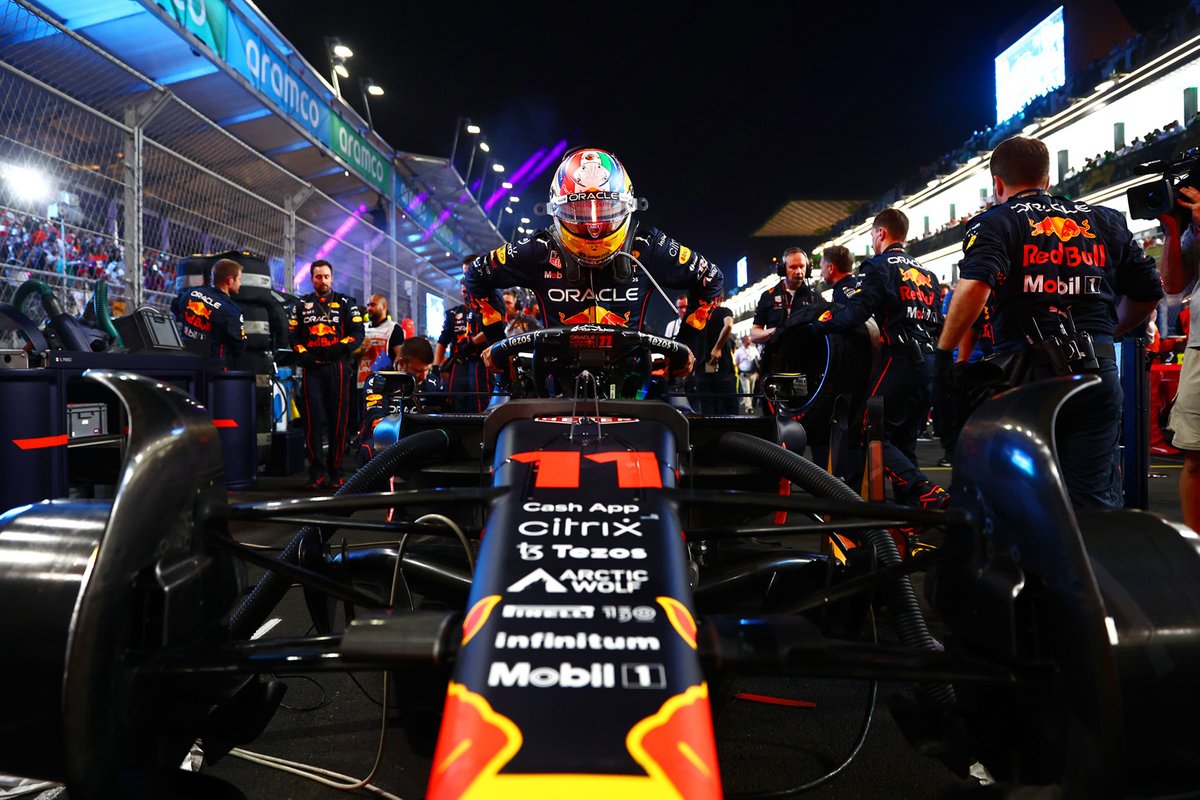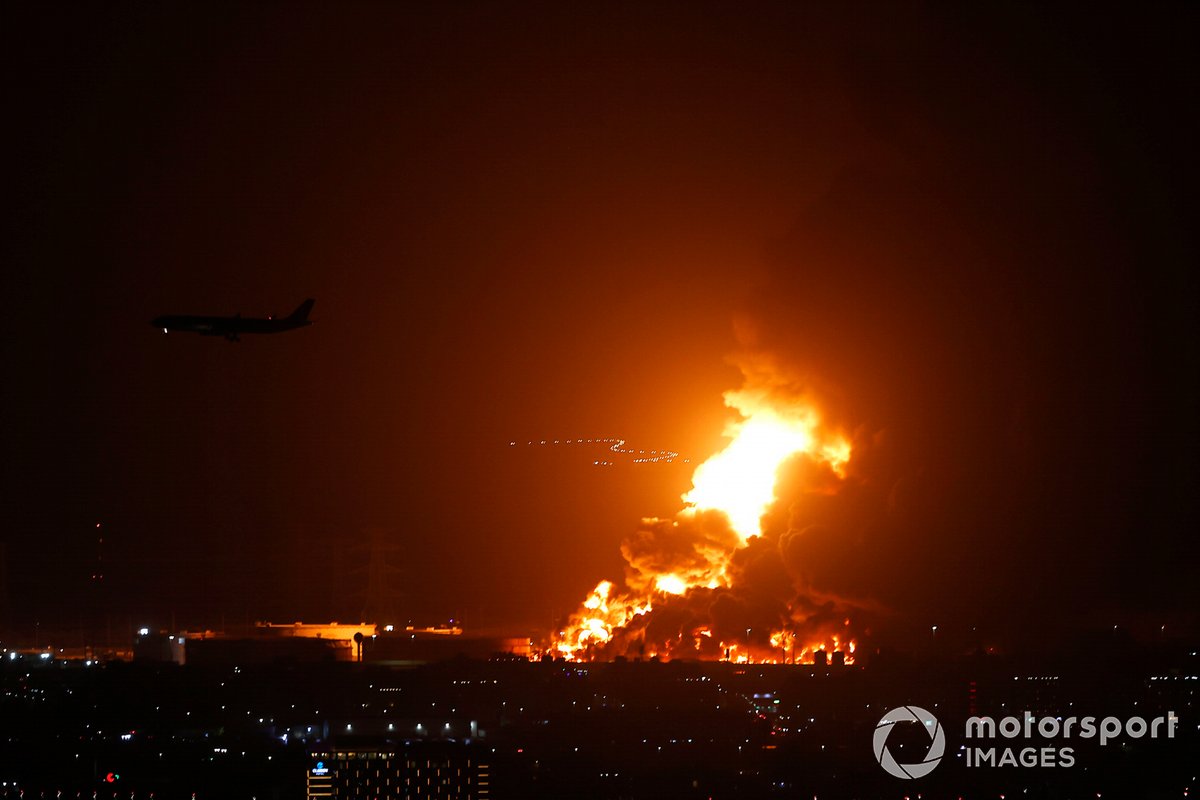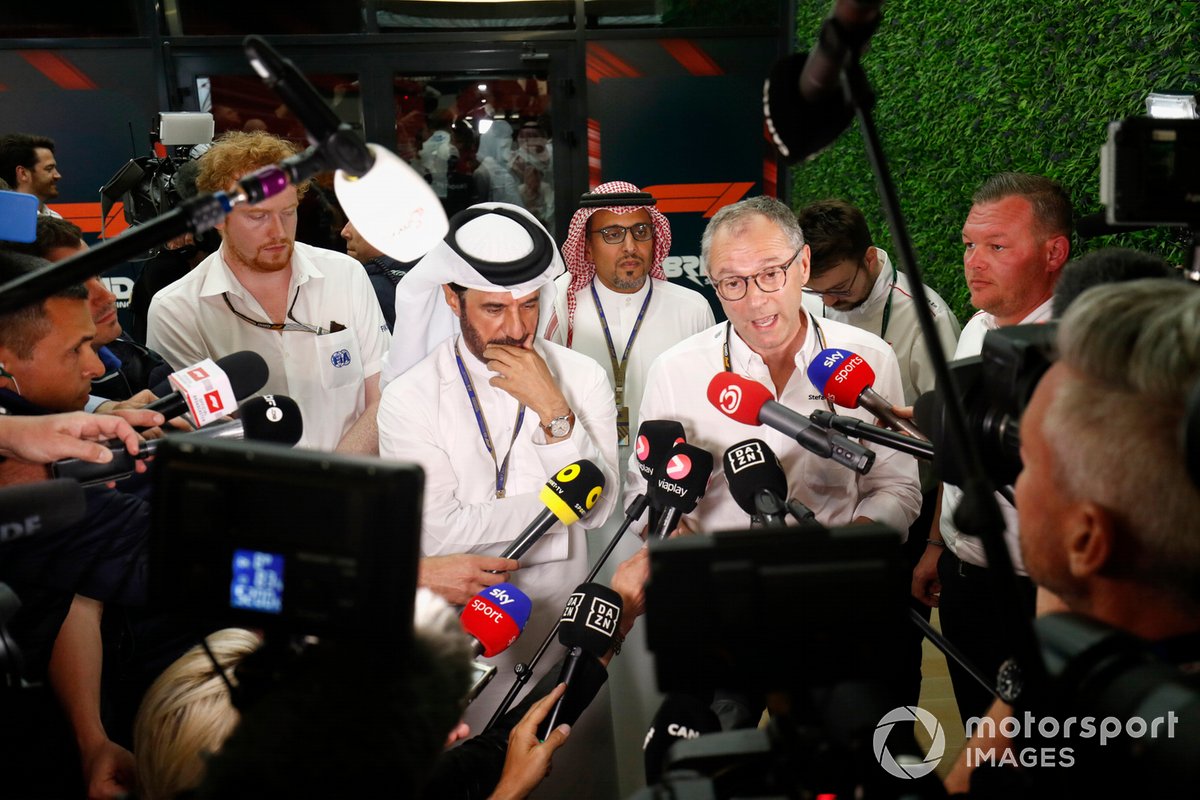The thrilling start to the 2022 Formula 1 season continued with a fascinating scrap for the win at the front of the Saudi Arabian Grand Prix between Max Verstappen and Charles Leclerc. But that was only after pole winner and early leader Sergio Perez had been done over by unfortunate safety car timing.
As it had in Bahrain a week earlier, the battle boiled down to a series of punch-and-counterpunch passes facilitated by the DRS overtaking aid. This split opinion on the nature of the fight in some quarters, but served up an intriguing race ending when it otherwise might have ended in a stalemate. Both victor and defeated rival were chuffed with how close and fair their fight had been once again.
Carlos Sainz and the unlucky Perez came home well adrift, but the pace advantage of the Red Bull and Ferrari cars relegated the rest to also-rans.
Not that there wasn't intrigue in the pack behind, where George Russell led the line for Mercedes, Esteban Ocon and Fernando Alonso each fought the other Alpine with no quarter given, and the recovering Lewis Hamilton and Kevin Magnussen also lost out to fate's timing. Plus, reliability dramas struck several squads at an event that now faces even more scrutiny.
Here are 10 things we learned from the 2022 Jeddah race.
1. Leclerc and Verstappen can really race, and race smart

Just as they did in Bahrain, Verstappen and Leclerc engaged in a lengthy wheel-to-wheel scrap for the win, which in this case lit up the closing stages. Again, Leclerc opted to base his tactics around the DRS zones, which meant attack ended up being his primary form of defence against Red Bull's faster package.
But this time Verstappen appeared to wise up faster and moved to try and disrupt Leclerc's plan – at the second time going into the final corner in their five-tour engagement, he locked up hard and lost speed, such was his desire to have DRS going onto the main straight. There, Leclerc stamped on the gas and roared clear, safe for another lap as he pulled away using Ferrari's mid-speed corner superiority around the first sector in Jeddah.
But the battle appeared to take too much from Leclerc's tyres and Verstappen, still aiming to be behind for the main straight DRS activation, was finally able to get ahead with a great run out of the final corner, a lap after the Ferrari had squirmed twice and lost crucial fractions to worn-tyre oversteer. The late Turn 1 yellow flag from Alex Albon and Lance Stroll crashing then stopped any hope of a Ferrari fightback.
2. DRS arguments aren't gone with the new cars

The fight in the closing stages was thrilling, but again ignited debate over the nature of the contest, as some observers felt DRS played too much of a part in proceedings. There was also debate about how Leclerc and Verstappen's tactics in driving to get the rear-wing-opening activation sat alongside their efforts in actually pulling off moves.
The overtaking aid has as long been a subject of dispute between F1 fans and in many ways it epitomises the championship's modern make-up: pure entertainment stacked up against sporting integrity. But here it lit up a contest between Leclerc and Verstappen that might well have fizzled out without a pass being made or even ended with yet more contact at this track if a moved was forced from very far back.
There is now mounting evidence that the 2022 car changes have changed things for the better when it comes to overtaking, with drivers able to follow closer and for longer. But the act of passing, says Verstappen, is actually more to do with yet another factor. And that's how the tyres perform with the heavier cars, as the load of the hefty machines "pushes you over the tyre edge" and adds tyre wear for a chasing rival.
So, it seems how DRS and fragile tyres fit in with F1's ethos will continue to be a source of contention even in this new era.
3. Red Bull has the ultimate pace edge over Ferrari

Red Bull ended pre-season testing with the quickest time and a sense that it had the superior overall package. That carried over into the Bahrain race before the team was undone by tyre and car balance getting away from Verstappen in qualifying. A similar scenario played out in Jeddah, where in qualifying Verstappen was held back by oversteer putting him over plenty of kerbs. But this time Perez rescued pole for Red Bull.
The key to the Mexican driver's first F1 career pole was his car's power unit punch meaning he could overcome the 0.3-seconds shipped to Leclerc in the first sector, where the Ferrari led the way. This also proved to be key to Verstappen's win once the safety car's appearance following Nicholas Latifi's second solo crash of the weekend took Perez out of contention.
With a slippery set-up designed to shed drag, combined with Ferrari packing on the downforce in a bid to ward against severe tyre degradation, Verstappen was able to top the speed trap and gain a crucial edge in his late-race fight with Leclerc. The DRS power made him all the more irresistible on the straights, but there is a sense that had the Red Bulls locked out the front row this might've been a much tamer contest.
4. The FIA can still needlessly confuse everyone

Sainz wasn't the only one left confused by the FIA's inaction over telling Red Bull to let him pass back by Perez during the safety car period. This is because it was clear on even the first reshowing of his pit exit line dash that he was fractionally ahead of his hard done by rival at the safety car line.
The Spaniard was eventually let through into the third place he would not lose, but was deprived of the chance to battle Verstappen at the restart, which might've given Ferrari a critical edge come the end of the race.
The governing body is leaving things such as contentious passes down to the teams and drivers to choose when it comes to possibly giving places back before the stewards need to get involved. But this one seemed so straightforward it was odd the new VAR-inspired officiating system couldn't tell Red Bull what to do while Niels Wittich supervised the clean-up of Latifi's crash and getting the safety car off the track.
As part of its reaction to the Abu Dhabi saga, the FIA has stopped the race director's post-race press conference. This is because it argues other sports don't have referees questioned directly. That's a fine point, but other sports don't have complex and lengthy rules that can be interpreted in various ways, as is the case in all forms of motorsport. And it's another decision that goes against the FIA's claimed intent to be more transparent heading forwards.
5. Russell can lead Mercedes in Hamilton's absence

A week on from Q3 rather getting away from him and letting Valtteri Bottas, Magnussen and Alonso get in between him and Hamilton, Russell really delivered on another difficult weekend for Mercedes. His start to life at the Silver Arrows may not be the championship challenge he has long dreamed of, but Russell produced an overall weekend performance in Jeddah that showed his worth to his new team and his class.
After he and Hamilton went different routes on set-up qualifying – the pair split over small set-up tweaks relating to rear wing drag configuration, which left Hamilton badly struggling for rear grip in Q1 – Russell ended up with a car balance that "felt good". That enabled him to have a strong and impressive race showing in the clear best-of-the-rest slot behind the Red Bull and Ferrari cars. It's just that Mercedes' deficit is currently so large that even when pushing on behind Sainz and Perez after the safety car, Russell ended up being "a second behind them generally".
It's also worth remembering Russell is still only 24 and had to shoulder plenty of responsibility as the only GPDA director on-site when the drivers took their stand over the race's viability on Friday night.
It's still too early to detect a pattern of what Mercedes driver he will ultimately be – Hamilton/Juan Manuel Fangio-esque, or with a reputation closer to Bottas – but how Russell stood out last weekend was very impressive.
6. Perez can deliver and even beat Verstappen in qualifying

Another driver who shone while their illustrious teammate struggled – albeit only really in qualifying for Verstappen – was Perez. Many were quick to point to the stat he now holds – the most races before clinching a first pole – given it is staggeringly high at 215 starts. This reflects how Perez's pedigree isn't in one-lap speed.
But he really pulled off a stunner on Saturday. At a venue where the super high-speed layout and close walls make getting the best out of a package even more of a tremendous challenge than it normally is, Perez produced a final Q3 run performance where he felt "I can do another 1000 laps, and I don't think I can improve this lap time".
Adding to the impressive nature of Perez's pole lap was that Red Bull had sacrificed one-lap performance by going to its low-drag philosophy, which paid it back in the race when the tyre wear wasn't the big factor Ferrari had feared. But it meant Perez really had to risk everything pushing on in Q3 and then rely heavily on his engine power to overcome Leclerc's early advantage. That he did it all while skipping between kerbs and taming oversteer snaps that even stymied Verstappen enhances what a good job Perez produced.
He led the race well early-on, although Leclerc was just starting to close before the first stops, but the safety car timing ultimately wrecked his result.
7. Reliability is a big concern for the new cars

It turned out that the fears over F1 introducing new cars leading to mass reliability failures during the early stages of testing were seriously wide of the mark – as they always were going to be, given it was not a change of engine formula. But where Barcelona's remarkably low red flag count was replaced with a much higher total in Bahrain and the two Red Bulls capitulated with a fuel vacuum issue in the race there, the Jeddah event ended with reliability worries for several squads.
Bottas's second impressive showing for Alfa Romeo was ended by a cooling issue, and while Alpine isn't so far giving an explanation for what stopped Alonso, his dash read "cool the car" as he crawled into the pits. Daniel Ricciardo's MCL36 also conked out at essentially the same time with a problem McLaren so far hasn't diagnosed, but it says it hasn't seen before. And Yuki Tsunoda missed both qualifying and the race due to separate water system and driveline issues.
It's early stages for the new formula and the Jeddah event is one of attrition given the cars must run so fast for so long in hot conditions, but it leaves plenty of teams needing to find answers fast to avoid losing further good results (Bottas and Alonso were running eighth and ninth, but in the hunt for a net sixth before they had to retire).
8. Alfa's start problem is going to be costly

For the second race in a row Zhou Guanyu had to grapple with his car's anti-stall system kicking in as he rounded the opening turns. This time it followed contact with Ricciardo's McLaren after the pack bunching up for Turn 1 left Zhou pinched in the inside kerbs. Zhou's car then immediately went into anti-stall and he lost ground getting out of it, having already been slow off the start line, and he finished the first lap at the rear of the pack.
The problem, Zhou said afterwards, is "related to clutch", which has a mechanical defect Alfa is currently racing to fix. As its drivers must be careful to provide consistent clutch operation and holding regular and stable revs, the issue causes severe wheelspin and poor launches at "like 50% of the starts", per Bottas, who lost out heavily off the line in the season opener.
This time he was able to able to hold his place despite a rather steady initial launch, but it is understood that Alfa may have to wait until round four and F1's brief return to Europe at Imola round before a mechanical fix is in place to remove the element of chance to a critical area of the race for its drivers.
9. Intra-Alpine fight was entertaining but costly for the team

Another notable feature of both the Bahrain and Saudi races was the Alpine drivers scrapping it out on track. On Sunday, Ocon's chop across Alonso's bows on lap five was thrilling, if wince-inducing for many onlookers – including those on Alpine's pitwall. Alonso got by using DRS to the outside of Turn 1 two tours later, but had to see off his teammate's continued advances at the Turn 2 and weaved at a subsequent run down the main straight.
All of it cost them both big time to Bottas behind. The battle continued for the next chunk of the race and featured Ocon cutting Turn 2 twice before he was ordered to hold station.
But while it provided a spicey back story for the race, which Ocon felt was "like a go-kart" contest and Alonso stressed "you need to give extra margin" with a teammate involved, it ultimately meant Bottas was able to close in twice and finally pass Ocon on lap 14. Given the Alfa's straight-line speed strength thanks to Ferrari's improved power unit for 2022, it would've been better for Alpine overall had it worked decisively to get its fastest car in front and then pull the other one along and stay ahead of the Alfa for as long as possible.
Ultimately the impact of the scrap counted for nothing as both Bottas and Alonso retired, with the latter feeling it is "disappointing to have only two points after two great weekends" so far in 2022. Ocon also avoided losing a place in a last-lap Jeddah drag race to the finish line this time around, as he prevailed in late-race scrap with Lando Norris.
10. F1 leaves Jeddah with serious questions to answer about the race's future

After F1's second Jeddah race in less than four completed months, the championship must address serious questions about the race's future. This is split into two elements: the track's safety status and the geo-political consequences of racing in Saudi Arabia at all.
On the first point, the race organisers made minor changes to wall placements at several corners following the 2021 event, which were primarily aimed at improving visibility for the drivers. But that did not diminish the overall problem of having cars race at such high speeds when the walls are so close, with even minor errors, such as a Mick Schumacher's slip two corners before he eventually ended up being too far over and too fast on the Turn 10 kerb in qualifying, resulting in huge accidents.
The Haas driver's crash cost F1 a car in the race, which itself was overshadowed by the nearby missile strike in FP1. That one of the reassurances given to the drivers concerned enough to be considering a boycott was that the race itself was not the target of the Houthi rebels wasn't actually reassuring at all.
F1 races in plenty of problematic places, but given Russia was dropped from the calendar for being involved in a conflict – and of course the two situations are not the same – questions must be asked if the Saudi race should get the same assessment.
Such logic could be applied to many instances in F1's history, but asking questions and speaking up on tough topics simply must continue instead of being swept away now the show is moving on to Australia.








